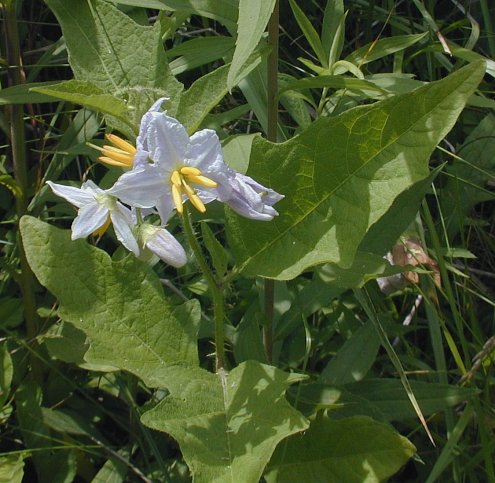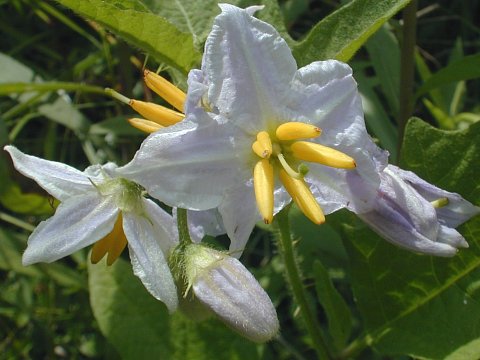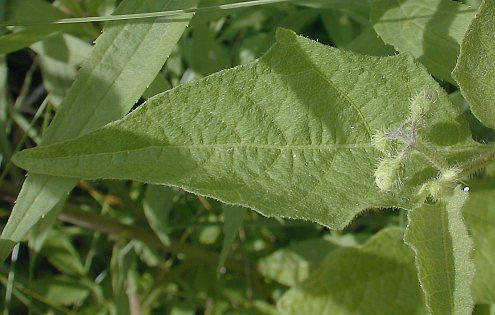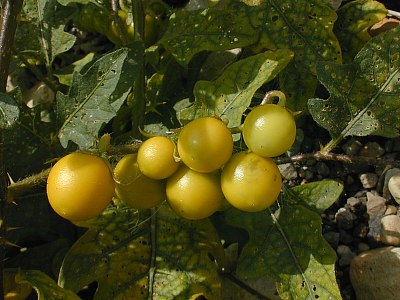Description: This herbaceous perennial plant is up to 3' tall, branching occasionally. The stems have scattered white or yellow spines. The alternate leaves are up to 6" long and 3" across, and have short petioles. They are broadly lanceolate or ovate, but rather angular along the margins, which are slightly ciliate. There are white hairs and scattered spines along the central vein on the underside of each leaf.

The upper stems terminate in small clusters of star-shaped flowers with hairy pedicels. These flowers are white or light violet, about ¾" across, and have 5 petals that are united at the base. Near the center, there are 5 elongated yellow anthers that are very prominent. There is no noticeable floral scent. The blooming period can occur from early summer to early fall, and typically lasts about 1½ months. Afterwards, round fruits develop that are a little more than ½" across and half-enclosed by a papery calyx. They become yellow when mature, but are not edible to humans. Each fruit contains numerous seeds that are glossy yellow and flattened. The root system has creeping underground rhizomes, which are responsible for the vegetative spread of this plant.

Cultivation:
The
preference is full sun and moist to dry conditions. Horse Nettle grows
readily in loamy or sandy soil, and probably other soil types as well.
It is a rather weedy plant that can become aggressive at disturbed
sites.
Range & Habitat:
The native Horse Nettle occurs in every county of Illinois and it is
very common (see Distribution
Map). Habitats include mesic to dry black soil prairies, clay
prairies, sand prairies, openings and edges of woodlands, abandoned
fields, areas along roadsides and railroads, yards and gardens, vacant
lots, and other waste areas. This plant is most typically observed in
disturbed areas, but it can be found occasionally even in high quality
habitats.

Faunal Associations: Bumblebees visit the flowers to collect pollen, using 'buzz pollination,' which involves the rapid vibration of thoracic muscles. The caterpillars of the day-flying moth Synanthedon rileyana (Riley's Clearwing) feed on Horse Nettle. This moth is a wasp mimic. The mature yellow fruits are eaten, to a limited extent, by the Ring-Necked Pheasant, Bobwhite, Wild Turkey, Eastern Striped Skunk, and possibly small rodents, thereby promoting the distribution of the seeds and spread of this plant. They are apparently more immune to the reduced toxicity of the mature fruit than humans. Experimental studies have shown that the seeds can pass unharmed through the digestive tracts of livestock. Mammalian herbivores avoid eating the stems and foliage of this plant because of their scattered spines and toxicity; the latter is the result of solanum, an alkaloid compound that also occurs in other members of the Nightshade family.

Photographic
Location:
The photographs were taken at the webmaster's apartment complex in
Urbana, Illinois, and a gravelly area along a railroad
in Champaign, Illinois.
Comments:
Horse Nettle is widely regarded as a weed with some justication, but
it is also one of the native wildflowers of the prairie. The fruits are
benefical to wildlife. Because of the intense competition among plants
and their root systems, this plant is less aggressive in prairie
habitats than in disturbed sites around developed areas.